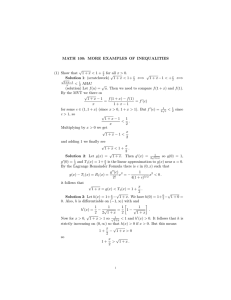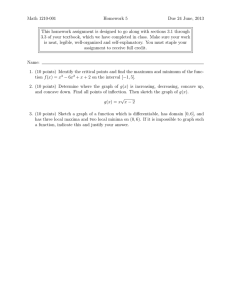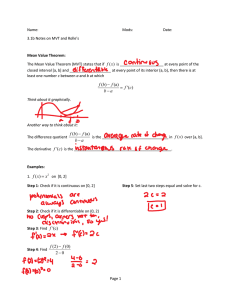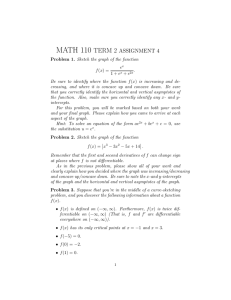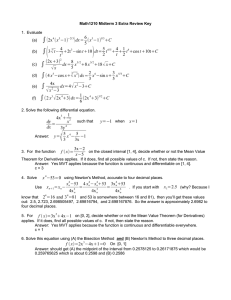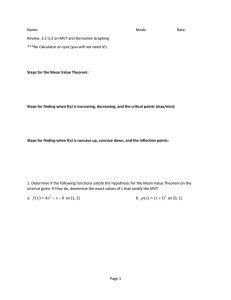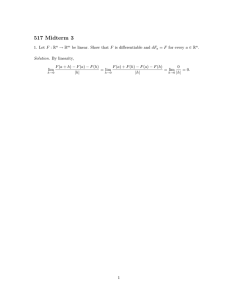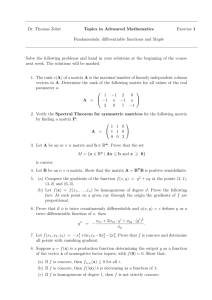Homework 7 5.1, 41. Since f(x) = −x 2 + 2 is continuous on [−1, 2
advertisement
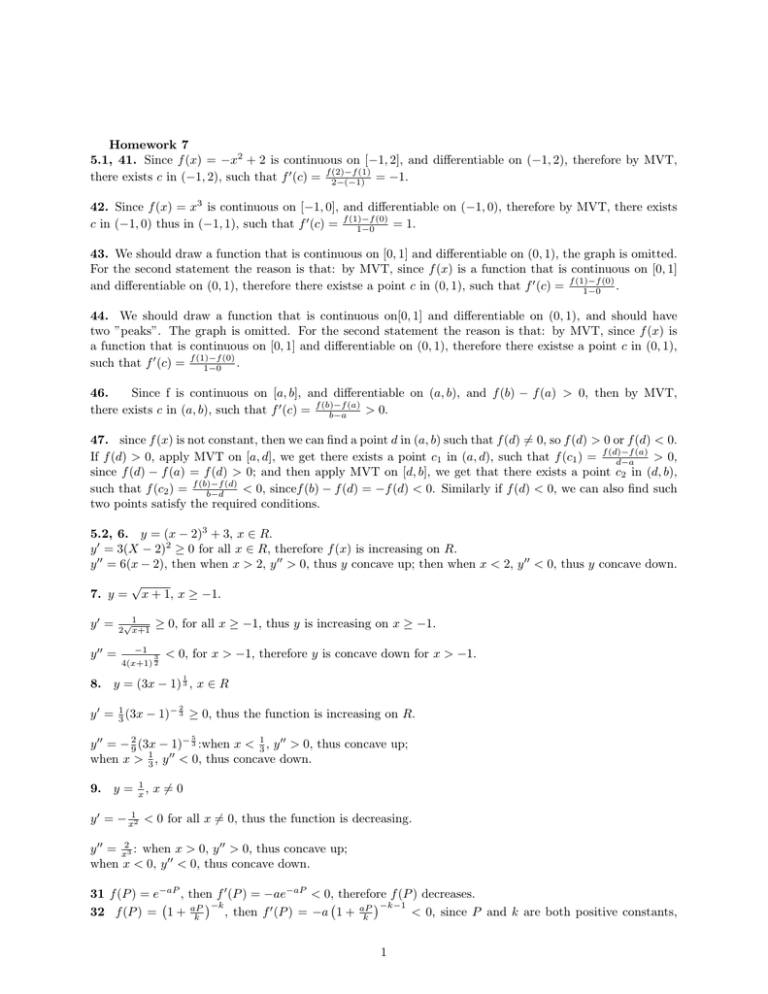
Homework 7 5.1, 41. Since f (x) = −x2 + 2 is continuous on [−1, 2], and differentiable on (−1, 2), therefore by MVT, (1) there exists c in (−1, 2), such that f 0 (c) = f (2)−f 2−(−1) = −1. 42. Since f (x) = x3 is continuous on [−1, 0], and differentiable on (−1, 0), therefore by MVT, there exists (0) = 1. c in (−1, 0) thus in (−1, 1), such that f 0 (c) = f (1)−f 1−0 43. We should draw a function that is continuous on [0, 1] and differentiable on (0, 1), the graph is omitted. For the second statement the reason is that: by MVT, since f (x) is a function that is continuous on [0, 1] (0) and differentiable on (0, 1), therefore there existse a point c in (0, 1), such that f 0 (c) = f (1)−f . 1−0 44. We should draw a function that is continuous on[0, 1] and differentiable on (0, 1), and should have two ”peaks”. The graph is omitted. For the second statement the reason is that: by MVT, since f (x) is a function that is continuous on [0, 1] and differentiable on (0, 1), therefore there existse a point c in (0, 1), (0) . such that f 0 (c) = f (1)−f 1−0 46. Since f is continuous on [a, b], and differentiable on (a, b), and f (b) − f (a) > 0, then by MVT, (a) there exists c in (a, b), such that f 0 (c) = f (b)−f > 0. b−a 47. since f (x) is not constant, then we can find a point d in (a, b) such that f (d) 6= 0, so f (d) > 0 or f (d) < 0. (a) If f (d) > 0, apply MVT on [a, d], we get there exists a point c1 in (a, d), such that f (c1 ) = f (d)−f > 0, d−a since f (d) − f (a) = f (d) > 0; and then apply MVT on [d, b], we get that there exists a point c2 in (d, b), (d) such that f (c2 ) = f (b)−f < 0, sincef (b) − f (d) = −f (d) < 0. Similarly if f (d) < 0, we can also find such b−d two points satisfy the required conditions. 5.2, 6. y = (x − 2)3 + 3, x ∈ R. y 0 = 3(X − 2)2 ≥ 0 for all x ∈ R, therefore f (x) is increasing on R. y 00 = 6(x − 2), then when x > 2, y 00 > 0, thus y concave up; then when x < 2, y 00 < 0, thus y concave down. 7. y = y0 = y 00 = √ x + 1, x ≥ −1. √1 2 x+1 ≥ 0, for all x ≥ −1, thus y is increasing on x ≥ −1. −1 3 4(x+1) 2 < 0, for x > −1, therefore y is concave down for x > −1. 1 8. y = (3x − 1) 3 , x ∈ R 2 y 0 = 13 (3x − 1)− 3 ≥ 0, thus the function is increasing on R. 5 y 00 = − 92 (3x − 1)− 3 :when x < 31 , y 00 > 0, thus concave up; when x > 13 , y 00 < 0, thus concave down. 9. y = x1 , x 6= 0 y 0 = − x12 < 0 for all x 6= 0, thus the function is decreasing. y 00 = x23 : when x > 0, y 00 > 0, thus concave up; when x < 0, y 00 < 0, thus concave down. 31 f (P ) = e−aP , then f 0 (P ) = −ae−aP < 0, therefore f (P ) decreases. −k −k−1 32 f (P ) = 1 + aP , then f 0 (P ) = −a 1 + aP < 0, since P and k are both positive constants, k k 1 therefore f (P ) decreases. √ 5.3 2. y = x − 1, 1 ≤ x ≤ 2. 1 y 0 = √x−1 > 0, for 1 < x ≤ 2, therefore the function is increasing. And for 1 ≤ x ≤ 2, the local maximum is (2, f (2)) = (2, 1), and the local minimum is (1, f (1)) = (1, 0), therefore the absolute maximum is (2, 1), and absolute minimum is (1, 0). 3. y = ln(2x − 1), 1 ≤ x ≤ 2. 2 > 0 for all 1 ≤ x ≤ 2, thus the local maximum is (2, f (2)) = (2, ln3), and the local minimum is y 0 = 2x−1 (1, f (1)) = (1, 0), therefore the absolute maximum is (2, ln3), and absolute minimum is (1, 0). x 4. y = ln x+1 , x > 0. 1 0 y = x(x+1) > 0, for all x > 0. therefore, there is no maximum or minimum. (5. )y = xe−x , 0 ≤ x ≤ 1 y 0 = e−x (1 − x) ≥ 0, for all 0 ≤ x ≤ 1, therefore the function is increasing. thus the local maximum is (1, f (1)) = (1, 1e ), and the local minimum is (0, f (0)) = (0, 0), therefore the absolute maximum is (1, 1e ), and absolute minimum is (0, 0) 19. f (x) = x3 − 2, x ∈ R. f 00 (x) = 6x, let f 00 (x) = 0. we get x = 0, and when x > 0, f 00 (x) > 0, and when x < 0, f 00 (x) < 0, therefore, at x = 0, the concavity changes, therefore, x = 0 is the inflection point of f (x). 20. f (x) = (x − 3)5 , x ∈ R. f 00 (x) = 20(x − 3)3 , let f 00 (x) = 0, we get x = 3, and when x > 3, f 00 (x > 0), and when x < 3, f 00 (x) < 0, therefore, at x = 3, the concavity changes, therefore x = 3is the inflection point of f (x). Draw a function f so that f 0 (x) is negative when x is negative, f 0 (x) is positive when x is positive, but f (0) is not a minimum. The function f (x) = − | x1 | for x 6= 0 works. 2
